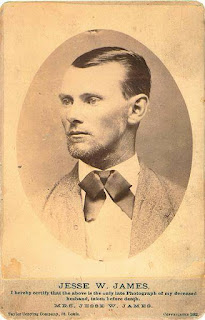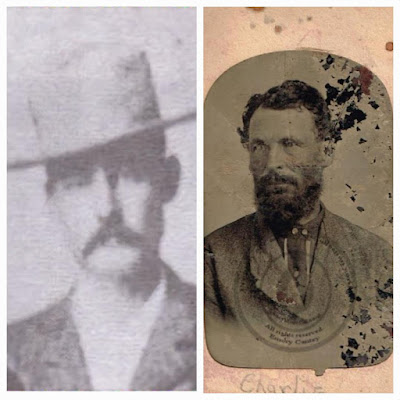Jesse James was spawned of that Civil War as a Quantrill Raider, and his fast gun-hand can be attributed to the new Navy Colts cap and ball pistols which set a faster pace in combat. But it is also speculated that Jesse and Frank were spies, secret operatives and covert soldiers. This author also believes that there is ample evidence to support this theory.
The end of the war was devastating for the south and Missouri had suffered a very strong divide within the state, which resulted a very difficult transition back to prosperity. Jesse and his brother Frank were caught in the crossfire of a post war world. There are indeed many crimes and incidents surrounding Jesse James and his family. There is in fact so much war and post war information on Jesse, that volumes have been written about it. But then we come to the statements or claims about Jesse James being evil incarnate, are they claims true? Facts tell us that this is probably true. Jesse and his gang surely robbed banks, trains and murdered more than a few people along they way. This can't be disputed. There are however other stories that tell a different tale about Jesse and Frank. It must also be mentioned, that despite what some people might say about Jesse and company, they seemed to have the support of most of the people in their community, and some of them were the neighbors of the James. family.
JESSE JAMES WAS MY NEIGHBOR
By Homer Croy
1949 The following story appeared in "Jesse James ,The Best writings on the Notorious Outlaw and His Gang . Edited by Harold Dellinger
One of the marked characteristics of Jesse James was his humor. He like to play pranks; rarely did he go through a robbery without saying something that had an element of humor. A good illustration of this is something that happened in the foothills of the Ozarks. One day the James-Youngers were taking a back road when noon came upon them. It was their custom to go to a farmhouse and get the wife to prepare a meal for them. And they always paid well. (I have not been able to find a single instance where they rode away without paying, or offering to pay.) They came to a humble cabin, and one of the group went to the door to ask the question. A woman answered "Haloo," a bit startled to see the mounted men. She didn't know whether she could cook the meal or not, she said, as there wasn't much to eat in the cabin. But she was finally prevailed upon. She watched the men dismount and seat themselves in the yard to wait till the meal was ready. As the men waited they were more and more impressed by the poverty of the cabin and by the hard struggle the woman had to live. Then they noticed that that the woman was weeping, And asked her if she was frightened? She said she wasn't, but that seeing the men in her cabin made her think of her husband. It developed that her husband was dead and that she was having to face her hardships alone. The men were appreciative of this and, glancing at each other decided to be liberal with her. Sensing this friendly sympathy, the woman choked up; She tried to hide her emotions but she was so wrought up that she was unsuccessful. .
Jesse said, :"Won't you tell us what's the matter?"
The woman hesitated, but at last the trouble came out. The cabin and her small farm were mortgaged to a heartless skinflint who had been pressing her for money. He warned her that if she did not have the mortgage money ready when he arrived, he would take her property. "He's coming today," She said again, beginning to weep. At last dinner was ready and the men sat down, Jesse, for the most part ate in silence, now and the glancing at the poor widow in her humble surroundings, finally he said, "How much do you owe this man?" Eight hundred dollars"... Jesse ate a few moments. "When did you say he was coming?" "This afternoon, about four." Jesse took a few more bites. "What does he look like?" She told him "How will he be traveling?" "In a democrat wagon, driving one horse." At the end of the meal Jesse pushed back in his chair. "What road does he usually take ?" The woman told him. "It just so happens," said Jesse, "I have that much money with me and I'm going to loan it to you."
The Woman looked at him with amazement. Was he joking? He wasn't. "You remind me of my mother said Jesse. "I want to do something for you" The woman began to weep again, "I'll work my fingers to the bone, I don't know when I can pay you back" She cried. Jesse patted her on the shoulder. "Don't worry about that. "I'll stop by sometime, then if you have it, you can pay back." The woman sobbed at her guests generosity. "Now you want to do this in a business like way." said Jesse. "He sounds like a hard man to deal with, so you to ought protect yourself." The gentleman here "Indicating Frank James.. "Will write out a receipt. Then you copy it in ink in your own handwriting. Before you pay with the money, make the man sign the receipt. Thats the proper way to conduct business, He'd make you do the same. And don't tell him anyone has been here." Now, will you do what I say?" "yes sir she cried, and said to Jesse, I think your wonderful." "I wouldn't say that," answered Jesse. He's a very kind hearted man" Explained Frank. Finally the men mounted their horses. In the door window stood the woman and waved goodbye to them.
That afternoon the skinflint called on the woman, signed the receipt and left. After he had driven about three miles away from her cabin on the way home, an unfortunate incident occurred. Suddenly three mounted men popped out of the timber; One seized the horses bridal an all leveled cruel looking weapons at him. The man chanced to have $800... But not for long. The horseman appropriated it, then whipped up his horse and sent it spinning down the road, leaving the mortgage holder, alone and on foot with the problem of catching his horse as best he could. Then, Three men rode away, No one knew where they went.


























.jpeg)





















